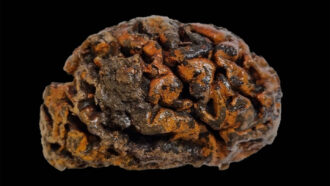Cool Jobs: Hunting surprises in thinning glaciers
As climate changes, these three scientists are enjoying some truly cool — if sometimes frigid — field work
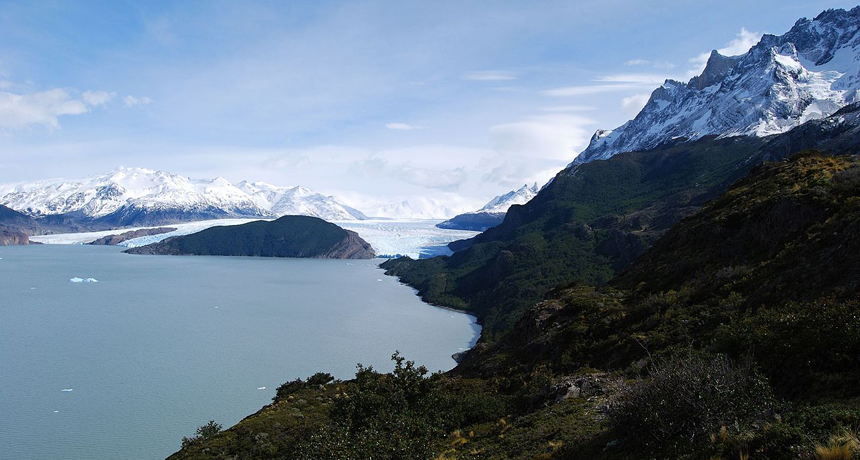
Grey Glacier, in Chile's Torres del Paine National Park, is one of the great many around the world that are now shrinking in size. Scientists are exploring what's behind this ice loss — and what these retreats are uncovering.
Pavel Špindler/Wikimedia commons CC BY 3.0
By Beth Geiger
Jon Riedel eyes the big backpack leaning on his pickup truck. An ice axe is strapped to one side of the pack. Two hundred feet of climbing rope lays coiled on top. A tent, sleeping bag, food and first aid gear are jammed inside. With a heave, Riedel shoulders the pack and hikes into the Olympic Mountains of Washington. He is headed to the Blue Glacier, almost 32 kilometers (20 miles) up the trail.
Glaciers are slowly moving rivers of ice. As snow accumulates over many years, the top layers press snow underneath into ice. Gradually, the weight of the ice causes it to flow downhill. Glaciers are fascinating, beautiful and essential in surprising ways.
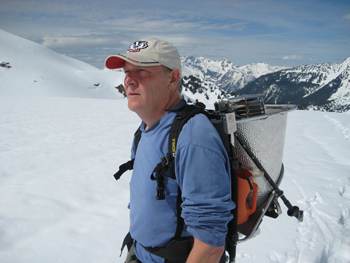
Riedel is a geologist with the National Park Service. He has spent years studying the glaciers that cling to the Pacific Northwest’s highest peaks. And he has documented something alarming: Those glaciers are melting, and fast.
Earth’s changing climate is causing this major meltdown. As they melt, glaciers are providing scientists with new views of climate change, worrying peeks into the future, and even some treasures.
Here, we meet three scientists who explore how melting glaciers are changing our world. Riedel records how fast mountain glaciers are shrinking and what that might mean for water sources. Another scientist travels to Antarctica to track the collapse of a massive ice shelf. A third looks for evidence of ancient humans exposed as ice disappears.
Mountain melt
Riedel and his team climb beside a tumbling stream. They thrash through thick brush and up a rocky mountainside. When they reach Blue Glacier, they rope themselves together in case someone falls into a dangerous, deep crack in the ice called a crevasse (Kreh-VASS). Finally, after climbing high up the glacier, they are ready to do some science.
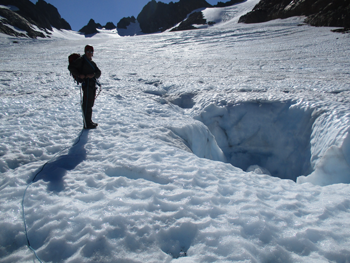
Every winter, as much as 6 meters (20 feet) of snow accumulates on Washington’s glaciers. Some remains. Some melts over the summer. The difference between how much accumulates and how much melts is the annual mass balance.
“Getting mass balance means visiting in person to measure actual snow depth,” explains Riedel. Three times each year, teams of National Park Service scientists visit the same eight glaciers. These glaciologists travel on foot, skis and sometimes by helicopter.
In April, they measure how much snow has accumulated since the previous summer. They use antennas from old military tanks, which are stiff enough to drive into dense snow, yet break down for easy transport. The researchers also pound plastic stakes into the glaciers, marking the snow level on them.
In mid-summer, the team checks on the stakes. In September, they return to measure how much more of each stake sticks above the snow. That reveals how much surface snow has melted off the glacier during the summer.
These mass balance measurements are at the heart of Riedel’s work. In addition, says Riedel, his team uses satellite photos to track changes in the glaciers/ total area.
After decades of study, one thing is clear. Nearly every glacier has a negative mass balance. They are melting. They cover less land, too. Some, like Lillian Glacier in Olympic National Park, have completely disappeared.
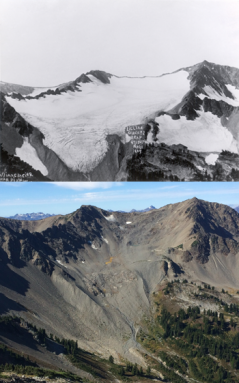
“Losses are pretty staggering in the last 50 years,” says Riedel. In the Olympic Mountains, for example, the total area covered by glaciers has shrunk by one-third just since 1982. What’s more, he explains, warmer winters mean that more precipitation is falling as rain, which runs off rather than accumulating as snow and ice. What this means, is that the year’s snow accumulation is shrinking while the melt season is growing. “It’s a double whammy,” he says.
Why care so much about some remote chunks of ice? Well, for one thing, explains Riedel, glaciers are habitat, part of the alpine ecosystem. But more importantly, they are a crucial source of water. Their summer-long melt keeps streams flowing throughout periods of long, dry heat. That water is essential for drinking, farming and fish. Riedel says that in some glacial-fed rivers that he tracks, flow has declined by almost a fourth over the last few decades.
These days, Riedel doesn’t always have the time to go onto the glaciers himself. “There’s a lot of background work besides field work,” he says. “Data management is a big deal.” That means chilling in front of a computer screen. Still, it’s hard not to look out the window at the mountains. “For someone who likes to be outside, the computer is kind of an anchor,” he says.
Crack up
Compared to glaciers in Antarctica, Jon Riedel’s glaciers are just tiny icicles. Antarctic glaciers can be bigger than whole U.S. states.
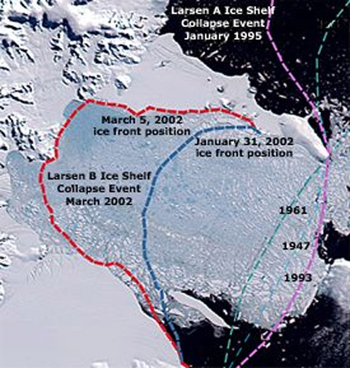
At the edge of Antarctica, glaciers extend onto the ocean in vast floating ice shelves. In March 2002, scientists were stunned when a vast piece of an Antarctic ice shelf, called Larsen B, suddenly disintegrated. The area that fell apart was the size of Rhode Island. Within weeks, most of the Larsen B had broken into a galaxy of icebergs.
Why did the ice shelf fall apart so fast? How has its collapse affected the environment, both near and far? And what’s next? Erin Pettit is on a mission to find out.
Pettit, who works at the University of Alaska in Fairbanks, didn’t start out studying glaciers. Instead, she began her career as a mechanical engineer. “My ‘aha’ moment didn’t come until I was a senior in college,” she recalls.
That’s when she realized she could apply her love of physics and engineering to the glaciers and mountains she enjoyed exploring. Even so, Pettit stuck with engineering for a while, designing electric cars. Then she finally turned to geophysics and glaciology. Now, with a PhD in geophysics, she is particularly interested in what happens inside glaciers — sites that only instruments can see.
Pettit finds Larsen B especially intriguing — and alarming. Climate here, in the Antarctica Peninsula, has warmed more than any other place in the southern hemisphere. Scientists now link the ice shelf’s collapse to this warming.
Though most of the ice shelf broke up and melted away, some clung on to the continent. Pettit and other scientists are watching this remnant. They want to know how — and when — the last bit of the Larsen B might fall apart.
They are also studying the land-based glaciers that had been connected to the ice shelf. Without the ice shelf to hold them back, says Pettit, these glaciers have sped up. They’re now flowing six to 10 times faster. They’ve also thinned by as much as 152 meters (500 feet) in just one six year period.
If all the ice just in west Antarctica slips away like this, that could cause sea level to rise 4.9 meters! Worse case scenario: if the ice covering all of Antarctica melted, sea level could rise 10 times that much (160 feet).
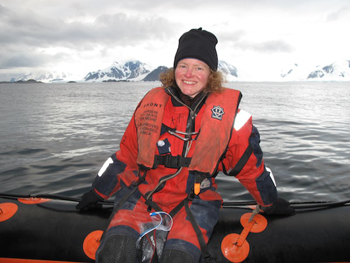
And Pettit’s findings could have even broader applications. Earlier this month, scientists reported that the Larsen C ice shelf looks poised to free itself from Antarctica soon.
Pettit and colleagues have a little help in their work from a friend in Antarctica called AMIGOS. That’s short for Automated Meteorological Ice Geophysical Observation Systems. AMIGOS measures ice conditions, weather, ocean currents and temperature. It also uses GPS (global positioning system) to precisely locate itself as the ice it rides on shifts. Every few hours AMIGOS sends all these data to the office of Pettit and other scientists.
Even with AMIGOS, Pettit still heads to Antarctica in person for field work. There, she lives in a tent pitched on the ice with other scientists. That may sound tough. But Pettit likes chilling on ice. She likes it so much, in fact, that she shares her passion for glaciers with high school girls in a summer program called Girls on Ice.
Hanging out on a glacier in Antarctica seems like a long way from designing cars. But for Pettit, the transition was natural. “Keep your mind open to new opportunities,” she says. “You never know where you might end up.”
Glacier ghosts
Hunting for ghosts gives Albert Hafner the chills. But not because he’s superstitious. It’s because Hafner looks for evidence of the dead in some of Europe’s coldest places.
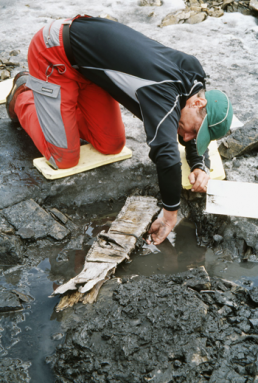
This archeologist with the University of Bern in Switzerland, studies human-related objects. His goal is to determine their history and significance. Hafner, who grew up in the Alps, says he was always fascinated by history. As a child, he learned about ancient villages that lay beneath the surface of Lake Geneva. By college, he had decided to study archeology. He spent the first half of his career mostly underwater before heading into the mountains.
Lately, Hafner has found treasures revealed by melting glaciers. Their ice had held these objects in its tight grip for centuries. No more. That may be bad for glaciers, but it’s a bonanza for archeologists. Hafner and colleagues call their emerging field “glacial archeology.”
Recently, Hafner has been trekking to a site called Schnidejoch Pass. It sits high in the Swiss Alps. There’s just a snow patch there now, surrounded by rock and other snow patches. But Hafner says that as recently as the 1970s this was all one glacier. “The site is definitely emerging because of climate change,” he says. “Just a generation ago not even climbers would go because of difficult access and crevasses.” Now Hafner hikes there over dry ground.
At Schnidejoch he discovered a wood bow, arrows and a quiver (or box used to carry the arrows). He and colleagues also found fragments of shoes and pants. To determine how old these were, Hafner sent pieces to a laboratory for analysis.
Carbon 14 is a radioactive isotope, a form of carbon. It is present in all living things, such as the tree used to make the wooden objects. When the plant or animal is alive, carbon 14 is constantly replenished from the atmosphere. But once that organism dies, carbon 14 levels begin to drop as the isotope decays. Bit by bit it will transform into an isotope of nitrogen. By measuring how much carbon 13 remains in an object, scientists can determine how long ago its living source had died. From that they date the approximate age of wood, bones or other objects.
Story continues below video.
A video by Scientific American’s Instant Egghead series
Michael Moyer, E. Olson and I. Soni
Glaciers had kept them frozen in time. Often, when people come across a bone or a wooden arrow near a glacier, they don’t even realize the object is ancient because it is so well preserved. But once the objects are thawed, they can disintegrate quickly.
From his finds, Hafner has pieced together a surprising story. He really has found a ghost. “We think one person came to death here about 2,800 B.C,” he says. That’s almost 6,000 years ago. The fact that someone was walking here at all suggests that Schnidejoch Pass was glacier-free back then. It probably was an important route for travel and trade. The ice that entombed these objects came later. Hafner and colleagues compare the importance of these finds to a more famous frozen find: Ötzi, a nearly intact, 5,300-year-old mummy discovered in the Alps in 1991.
Some objects emerging from glaciers won’t be so surprising, or so intact. Hafner tells the story of an American military plane that crashed onto a Swiss glacier in 1946. The people were rescued. But after 70-plus years, the plane has sunk deep into the glacier. Because the glacier is moving, Hafner expects that it will start to spit out the plane pretty soon. The glaciers’ churning won’t have been kind to it. “The plane will come out in very small pieces,” he predicts.
Like that plane, most things that fall into glaciers get chewed up. But sometimes, such as at Schnidejoch, objects end up in a natural depression, protected from the grinding action of that moving ice. That’s when archeologists get lucky. Hafner hopes that is the case as he contemplates warmer times ahead. “We can expect more finds in the future,” he says.
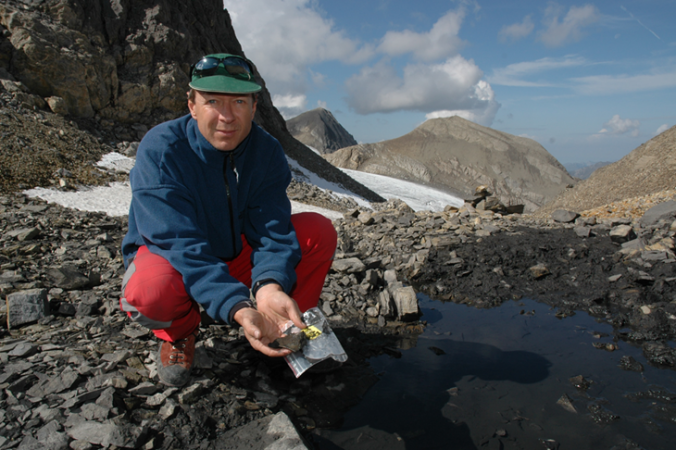
This is one in a series on careers in science, technology, engineering and mathematics made possible with generous support from Arconic Foundation.







